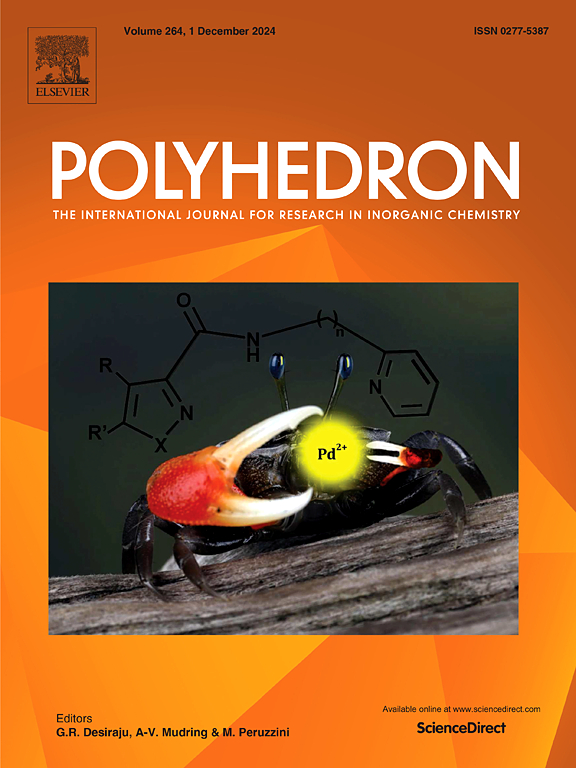揭示bodipy -钌(II)多吡啶配合物的光化学途径:合成、表征和光氧化行为
IF 2.6
3区 化学
Q2 CHEMISTRY, INORGANIC & NUCLEAR
引用次数: 0
摘要
光催化是合成化学克服合成挑战和生产新材料的有力策略。为了开发更可持续的光催化转化和发现新的反应活性,新型光催化剂的制备及其效果的研究具有重要意义。在本研究中,钌(II)多吡啶配合物由于其广泛的配位化学、高效的光化学活性和光氧化过程的改善潜力而受到关注。采用简单的合成路线合成了bodipy -钌(II)多吡啶配合物,并利用光谱技术对其进行了详细的表征。该配合物在506 ~ 546 nm范围内有较强的吸收,在518 ~ 570 nm范围内有中等的发射,单重态氧量子产率在0.12 ~ 0.46之间。在1,5-二羟基萘的光氧化反应中,仅使用1%的配合物作为光催化剂,在10分钟内转化率高达50%。光化学行为,如高效的单线态产氧和光氧化活性增强,指出了配合物在化学转化反应和环境修复中的潜在应用。这些结果为这些配合物的设计和优化提供了见解,为未来的光化学应用提供了参考。本文章由计算机程序翻译,如有差异,请以英文原文为准。

Revealing the photochemical pathways of BODIPY-ruthenium(II) Polypyridyl complexes: Synthesis, characterization, and Photooxidation behavior
Photocatalysis is a powerful strategy for synthetic chemistry to overcome synthetic challenges and enable the production of new materials. In order to develop more sustainable photocatalytic transformations and discover new reactivities, the preparation of new photocatalysts and investigation of their effects are of great importance. In this study, ruthenium(II) polypyridyl complexes were focused on due to their versatile coordination chemistry, efficient photochemical activities and potential for improvement of photooxidation processes. BODIPY-Ruthenium(II) polypyridyl complexes were synthesized using a straightforward synthetic route, followed by detailed characterizations using spectroscopic techniques. The complexes showed strong absorption in the range 506–546 nm, moderate emission in the range 518–570 nm and singlet oxygen quantum yield in the range 0.12–0.46. In the photooxidation reaction of 1,5-Dihydroxynaphthalene in which only 1 % of the complexes were used as photocatalysts, a conversion rate of up to 50 % was achieved within 10 min. Photochemical behaviors such as efficient singlet oxygen production and enhanced photooxidation activity pointed to potential applications of the complexes in chemical transformation reactions and environmental remediation. The results provide insights into the design and optimization of these complexes for future photochemical applications.
求助全文
通过发布文献求助,成功后即可免费获取论文全文。
去求助
来源期刊

Polyhedron
化学-晶体学
CiteScore
4.90
自引率
7.70%
发文量
515
审稿时长
2 months
期刊介绍:
Polyhedron publishes original, fundamental, experimental and theoretical work of the highest quality in all the major areas of inorganic chemistry. This includes synthetic chemistry, coordination chemistry, organometallic chemistry, bioinorganic chemistry, and solid-state and materials chemistry.
Papers should be significant pieces of work, and all new compounds must be appropriately characterized. The inclusion of single-crystal X-ray structural data is strongly encouraged, but papers reporting only the X-ray structure determination of a single compound will usually not be considered. Papers on solid-state or materials chemistry will be expected to have a significant molecular chemistry component (such as the synthesis and characterization of the molecular precursors and/or a systematic study of the use of different precursors or reaction conditions) or demonstrate a cutting-edge application (for example inorganic materials for energy applications). Papers dealing only with stability constants are not considered.
 求助内容:
求助内容: 应助结果提醒方式:
应助结果提醒方式:


